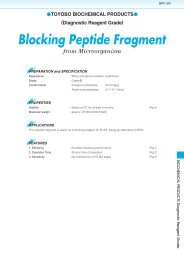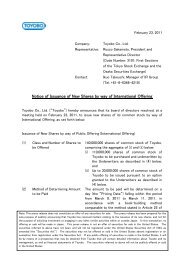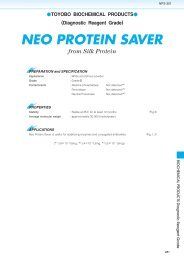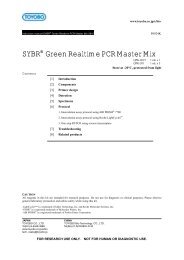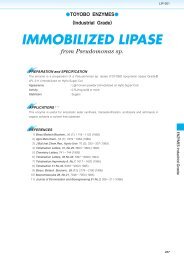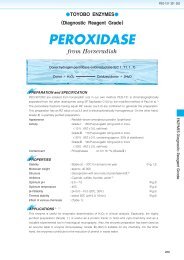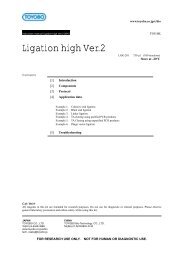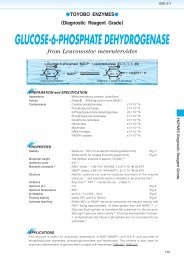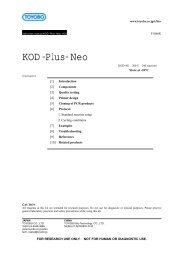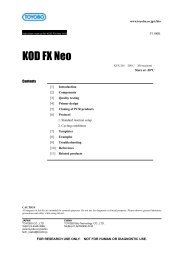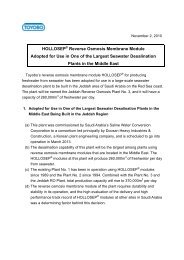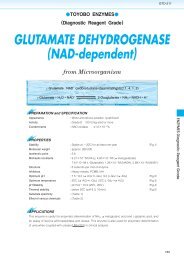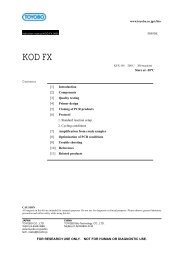HEXOKINASE - Toyobo
HEXOKINASE - Toyobo
HEXOKINASE - Toyobo
Create successful ePaper yourself
Turn your PDF publications into a flip-book with our unique Google optimized e-Paper software.
HXK-301<br />
ASSAY<br />
Principle:<br />
hexokinase<br />
D-GlucoseATP<br />
Glucose-6-phosphateNAD <br />
D-Glucose-6-phosphateADP<br />
G-6-PDH<br />
Glucono--lactone-6-phosphateNADHH <br />
The appearance of NADH is measured at 340nm by spectrophotometry.<br />
Unit definition:<br />
One unit causes the formation of one micromole of NADH per minute under the conditions described below.<br />
Method:<br />
Reagents<br />
A. Tris-HCl buffer, pH 8.0<br />
B. Glucose solution<br />
C. ATP solution<br />
D. NAD solution<br />
E. G-6-PDH solution<br />
F. Enzyme diluent<br />
50mM, containing 13.3mM MgCl 2<br />
0.67M in Tris-HCI buffer solution (A) (Should be prepared fresh)<br />
16.5mM in Tris-HCl buffer solution (A) (Should be prepared fresh)<br />
6.8mM in Tris-HCl buffer solution (A) (Should be prepared fresh)<br />
300U/ml (Dilute with Tris-HCl buffer solution (A) and store on ice)<br />
Tris-HCl buffer solution (A) contg. 0.1% of bovine serum albumin<br />
Procedure<br />
1. Prepare the following reagent mixture in a cuvette (d1.0cm)<br />
Concentration in assay mixture<br />
and equilibrate at 30 for about 5 minutes.<br />
Tris-HCl buffer<br />
50 mM<br />
2.3 ml Tris-HCl buffer solution, pH 8.0 (A) Glucose<br />
0.11 M<br />
ATP<br />
0.55 mM<br />
0.50ml Glucose solution (B)<br />
NAD <br />
0.23 mM<br />
0.10ml ATP solution (C)<br />
MgCl 2<br />
13 mM<br />
0.10ml NAD solution (D) BSA<br />
3.3g/ml<br />
0.01ml G-6-PDH solution (E) G-6-PDH<br />
ca.1.0 U/ml<br />
2. Add 0.1ml of the enzyme solutionand mix by gentle inversion.<br />
3. Record the increase in optical density at 340nm against water for 2 to 3 minutes in a spectrophotometer<br />
thermostated at 30 and calculate theOD per minute from the initial linear portion of the curve (OD<br />
test).<br />
At the same time, measure the blank rate (OD blank) by using the same method as the test except that<br />
the enzyme diluent (F) is added instead of the enzyme solution.<br />
<br />
Dissolve the enzyme preparation in ice-cold enzyme diluent (F), dilute to 0.10.2U/ml with the same buffer<br />
and store on ice.<br />
Calculation<br />
Activity can be calculated by using the following formula<br />
OD/min (OD testOD blank)Vtdf<br />
Volume activity (U/ml) <br />
6.221.0Vs<br />
Weight activity (U/mg)(U/ml)1/C<br />
Vt Total volume (3.11ml)<br />
Vs Sample volume (0.1ml)<br />
6.22 Millimolar extinction coefficient of NADH (F/micromole)<br />
1.0 Light path length (cm)<br />
df Dilution factor<br />
C Enzyme concentration in dissolution (c mg/ml)<br />
OD/min5.0df<br />
REFERENCES<br />
1) I.T.Schulze et al.; J.Biol.Chem., 244, 2306 (1969).<br />
2) E.M.Bessell et al.; Bilchem.J., 128, 199 (1972).<br />
3) J.J.Schmidt et al.; Arch.Biochem.Blophys., 158, 458 (1973).<br />
4) M.R.McDonals; Methods in Engymology, vol.1, p.269 Academic press, New York (1955).<br />
5) A.Sole et al.; Biochem.Blophys.Acta, 30, 92 (1958).<br />
6) W.H.Harrison and R.M.Gray; Arch.Biochem.Blophys., 151, 357 (1972).



